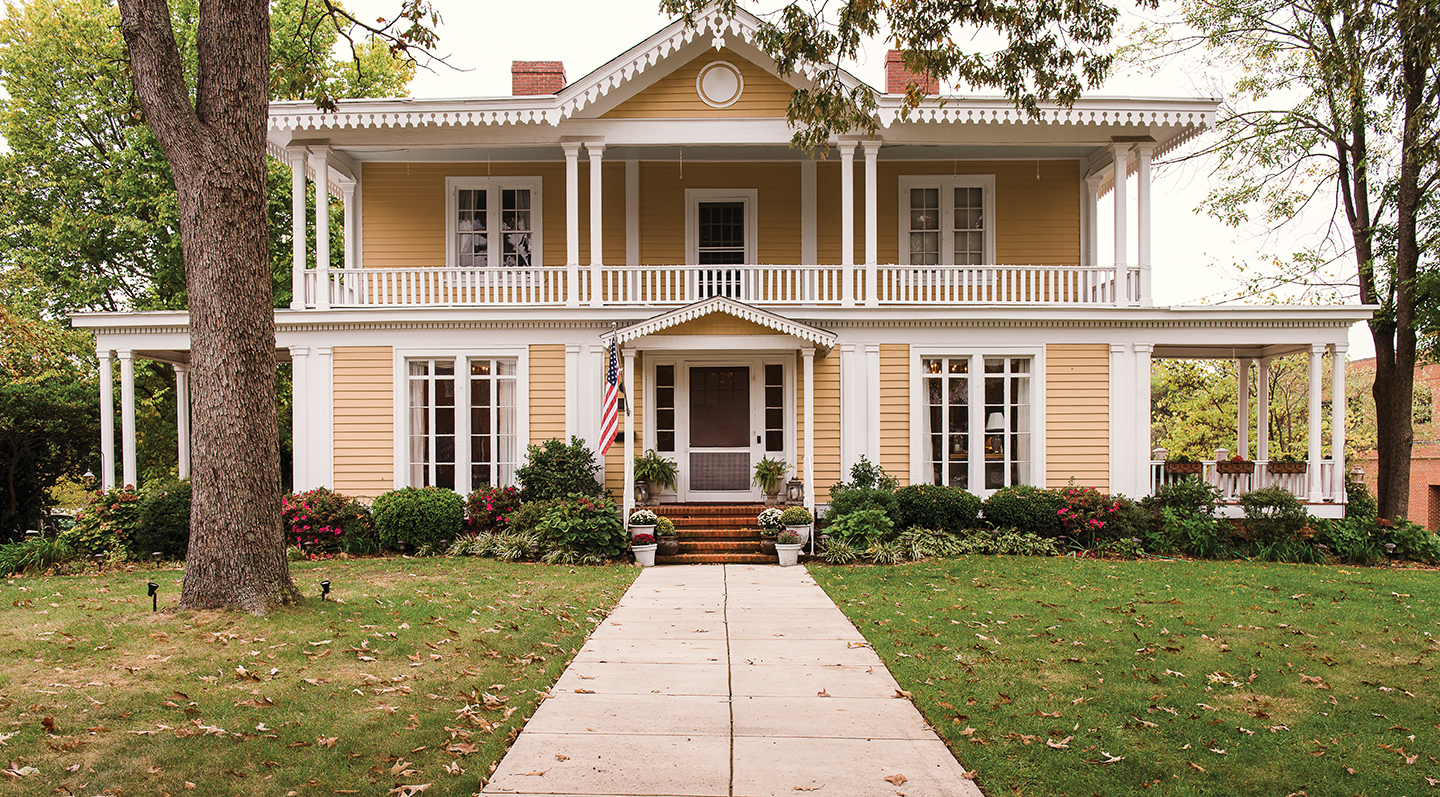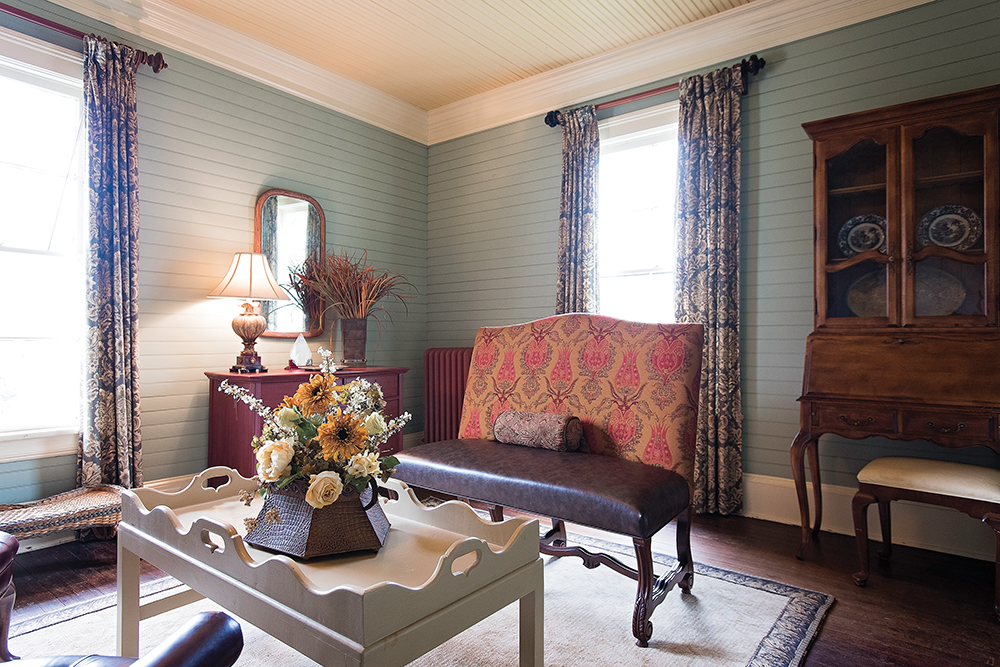
The Weir-Jordan house is firmly wedded to Greensboro’s past
By Billy Ingram • Photographs by Amy Freeman

For the last 171 years, the veranda at the Weir-Jordan House at 223 North Edgeworth has been a not-so-silent witness to history — through Civil War and Reconstruction, Greensboro emerging from Greensborough, the Great Depression, two world wars, civil rights and women’s suffrage — a living testament to that fabled antebellum Southern charm thought lost to the ages.
Around the turn of the 20th century, when John Motley Morehead’s home Blandwood was her nearest neighbor, the Weir-Jordan home watched as the surrounding wilderness was developed into a charming neighborhood where generations of children were raised on the northwest edge of a burgeoning downtown. In the 1920s, one of our magnificent churches, Grace United Methodist, sprang up across the street while the Jefferson Pilot building rose in the distance, followed by more modern skyscrapers. As the center city expanded outward in the ’60s and ’70s, most of the homes in this neighborhood were razed and replaced by office complexes or were repurposed for locally owned businesses. So much so that Weir-Jordan is one of only three houses remaining north of Friendly on Edgeworth.
It has survived, and thrived, thanks to the stewardship of the Greensboro Woman’s Club, which has owned the home since 1921. Established in 1909, the Greensboro Women’s Club’s 157 initial members banded together in a push for “Better schools and community.” And, as it turns out, the preservation of what we believe to be one of the first 10 homes built downtown. The interior of the house features a double-pile floor plan with Greek Revival touches, four-panel doors, molded baseboards, and pilaster-and-frieze mantels. “There’s never been a major renovation of the entire house,” past president and Chairman of the Board of the Woman’s Club, Nancy McKee, tells me.
“These are the original plaster moldings. All the floors are original, the fireplaces, center hall, steps, newel, all of this is original [to Dr. Weir’s home].”
Greensborough was a “somnolent little Southern town” of around 400 people when Dr. David P. Weir established his successful medical practice in 1840, the next year he partnered in Jesse Lynsey’s drugstore not far from McConnel’s Dry Goods store. There was gold in them thar hills. North Carolina, in fact, was first in the nation in gold strikes and Guilford County was no exception. The Iron Horse had yet to ride any closer than Raleigh, so traveling by horse and buggy was the ultimate in luxury and sophistication in these parts. It was the dawn of the Crinoline Age when ladies wore inch-above-the-floor length dresses over hoop skirts, cinched tightly at the waist, while gentlemen sported long hair and whiskers, straw hats and tight fitting suits with tail coats.
In 1844, Dr. Wier was briefly in charge of the Edgeworth Female Seminary, a finishing school located on a plot of land situated directly between Governor Motley Morehead’s mansion Blandwood and the 6- acre tract where Dr. Weir began construction on his two-story home after marrying Susan Dick Humphreys in 1846.
Therein lies the mystery of Weir’s homestead. The important structures in its vicinity, Blandwood’s Italianate additions and the Edgeworth seminary, along with Greensboro College’s main building (the latter two destroyed by fire), were designed by renowned architect Alexander Jackson Davis of New York during this time period. We know Davis, who years earlier designed the State Capitol in Raleigh, presented Weir with floor plans for a home but it’s never been determined whether that plan was used or not. Davis drew inspiration from a number of architectural periods, having no one dominate style, so a home designed in the Antebellum Domestic architectural style prevalent in the Piedmont at that time, with Gothic and Italianate touches, wouldn’t be completely out of character.
Business was flourishing downtown in the summer of ’48, boasting a shopping district newly populated by a cobbler, tailor, haberdashery and a ready made clothing store located nearby Hopskin’s Hotel. That’s when Dr. Weir partnered with eccentric physician Algernon Sidney Porter to buy the Greensborough Drug Store, one of two druggists in town. Porter, who had been selling apothecaries at the old stand on North Street, took out an advertisement in the Greensborough Patriot asking those who were indebted to him to, “come forward and make settlement. May you have no power to resist!” the ad read.
Weir & Porter stocked “a large and well-selected assortment of drugs and medicines at a small advance above New York cost,” potions like Syrup of Naphtha, a cure for consumption, and Electric Lotion Pain Eradicator — basically granny’s rheumatism medicine. They also sold Bibles for the Guilford County Bible Society, although if the purchaser couldn’t afford one at “Society prices,” the Good Book would be “supplied gratuitously.”
This partnership was short-lived. Weir bought out Porter’s interest in the drugstore the next year. In their home around the corner on West Market, “Dr. Al” Porter and his wife Mary Jane Virginia Swaim Porter gave birth in 1862 to their third child, William Sidney, who would one day achieve fame as the writer O.Henry. A friend of O.Henry’s recalled the freckle-faced lad as he serenaded giggling seminary schoolgirls in 1880, “I can see Will Porter right now with his foot on a stump and his fiddle across his knee saying to Charlie Collins, ‘Charlie, gimme your a.’. One number we sure could play — the “Old Saltello Waltz” — because we played it at every concert . . . The funny thing about this waltz was that, so far as we knew, it had no stopping place, no end. We just kept on playing and playing until Charlie Collins would say, ‘Look out fellers, I’m going to stop!’”
Weir went on to become a founding member of Greensborough’s first life insurance company, one of only a few dozen in the nation, while his wife Susan was as a key participant of The Ladies of Greensboro, who were very active during the Civil War. It was her task to collect provisions donated by the public and then see that they were distributed to battlefields in need. In addition, she supervised the sewing of troop uniforms.
A senior representative of the Sons of Temperance, Dr. David Weir died of consumption in 1865. After Susan Weir (Bell) passed on in 1890, the home was sold to prominent tobacconist, city commissioner and director of the Chamber of Commerce James F. Jordan for $5,000.
Because the house was so closely associated with the well-known Weirs, Jordan added his own imprimatur. Pointing to the initial ‘J’ on either side of the twin fireplaces, Nancy McKee reveals, “These were added in the 1900s when James Jordan owned the house. He was responsible for bringing a lot of Northerners down who liked to hunt.” Described in the press as ”one of the best marksmen in the South” Jordan, an inveterate fox hunter, was responsible for luring tobacco tycoon Pierre Lorillard to Greensboro; J. P. Morgan was another likely visitor to the home; he owned a hunting lodge near Climax.
It made the newspapers when a doctor in New York gave Jordan with, “a fine Winchester repeating rifle, model of ‘94. It carries twenty-five loads and is one of the most effective weapons ever seen here.” That gift almost led to the demise of his home in 1904. Jordan’s son and daughter were playing in the living room when a servant accidentally swept one of the cartridges into a fireplace where it exploded; the bullet grazed the little girl’s heel, while the resulting explosion of hot coals very nearly set the house on fire.
As for what the interior decorating looked like in those days, McKee says, “A graduate student in UNCG’s architectural design department did a color analysis of all the paint, so we know what colors the original walls were and how long they were up. They determined that by the dust layer in between.” What they discovered was a surprise: “I think most people assumed the walls were white or beige, but they were not.” They were red and blue-green, with the rooms downstairs yellow. “Some very bright colors were used,” McKee says.
When Jordan retired in 1906, after being reelected Sheriff twice, he purchased 300 acres of land on both sides of South Buffalo Creek, along the macadam road leading to Alamance Church, which he then subdivided into farms and smaller tracts, selling them at an auction said to have attracted some 10,000 potential buyers. Jordan’s widow, Mary, sold the house, situated on a smaller lot, in 1921 before it was subsequently acquired by The Greensboro Woman’s Club.
Making your way up the long walkway to the entrance of Weir-Jordan today, one can’t help but be struck with an unmistakable sense of the authentic antiquity it represents and how lucky we are to possess this pre-Civil War masterwork. Nancy McKee tells me, “The thing that keeps the house going are the rental fees from around a dozen civic and service groups that meet here on a monthly basis and we would love to accommodate more.” In addition, the revenue from private and corporate events, Christmas parties, rehearsal dinners and weddings serve to maintain this jewel.
You might imagine The Woman’s Club as being ladies in white gloves enjoying formal teas, playing bridge. And that was certainly a component at one time. Nowadays, they are, and have been for some time, much more focused on community activism. While initially working toward improving education and teachers’ pay, in 1917, the organization was instrumental in starting the local chapter of the American Red Cross. Five years later they established the city’s first curb market.
The Woman’s Club held its Cotton Ball at the new King Cotton Hotel in 1927, a cotillion celebrating the cash crop that fueled the South. At least a thousand partiers were presided over by a “royal court” headed by a King and Queen, a photo of the courtiers appeared in The New York Times’ rotogravure.
During the Second World War, these Wonder Women established a War Service Department that ‘adopted’ the wives of military officers serving at the Overseas Replacement Depot, planted victory gardens, and promoted the “Buy a Bomber” campaign that nationally raised enough money to purchase 431 fighter aircraft.
In 1961, the Woman’s Club enlarged the interior of the house by enclosing the first level of the two-story front porch. This was accomplished by pushing out the original front wall and retaining the original sash and trim. During that decade, the group sponsored the Greensboro Seniorettes Club at Grimsley High to promote “healthy activities, intellectual curiosity and spiritual compassion” and spearheaded projects to aid in the national war on poverty.
In the 1970s the club fought for ratification of the Equal Rights Amendment (spoiler alert: it still hasn’t passed) and sponsored an 18 1/2 hour telethon on WFMY that raised $212,000 for the North Carolina Zoo, enough to complete construction on the East African phase.
Despite the fact that membership roles have fallen to about 15 percent from its peak in the 1940s, that level of civic involvement continues unabated. Among the club’s projects: involvement in Urban Ministries’ Feast of Caring, along with animal rescue and foster programs, awarding of scholarships to high school seniors, making blankets for residents of Bell House, walks to fight breast cancer, support for Victory Junction for seriously ill children, and the decades-long tradition of wrapping Christmas presents at Friendly Center to raise money for charity.
Securely woven into the fabric of an ever-shifting landscape is this precious wedding cake of a house, Weir-Jordan, with an interior that has been described by the National Register of Historic Places application as retaining, “its original center hall plan and most of its simple finish. The stair which displays such typical mid-19th century features as a turned newel, turned balusters, and a molded handrail, rises in a tight, steep curve from what is now the front of the hall to a rear landing.”
As recently as the 1980s, there was a little old lady who lived upstairs and served as caretaker and cook when this was more of a clubhouse. Since then, the bathrooms have been modernized and WiFi and central air have been added. The kitchen has been outfitted as a state-of-the-art commercial banquet facility as McKee points out, “Stacy Street is our caterer, and she does fabulous weddings with big white tinsel on the front lawn; it’s gorgeous.” Bedrooms upstairs serve as separate bride and groom dressing areas.
The impressive upstairs veranda with its chamfered posts supporting a full-facade upper tier overlooks the grand front lawn. “Brides love to come here to have their pictures taken over the railing, with the photographer looking up,” McKee says. “It’s perfect for bouquet tossing and garter showings.” Banners and bunting can be hung from the railing for added dramatic effect.
As in days of old, ladies in hoop skirts and white crinoline, accompanied by gentlemen in fitted formal wear, can be seen dancing and celebrating on the front lawn, once shaded by large trees, now manicured and lusciously landscaped. McKee explains, “When brides call about having their wedding here, they express interest in wanting to get married in a Southern home; they want to be a part of Greensboro history.” OH
For more information about The Greensboro Woman’s Club, go to greensborowomansclub.com.
Billy Ingram moved to downtown Greensboro 20 years ago after a career in Los Angeles as one of the team the ad world dubbed “The New York Yankees of Motion Picture Advertising.”





